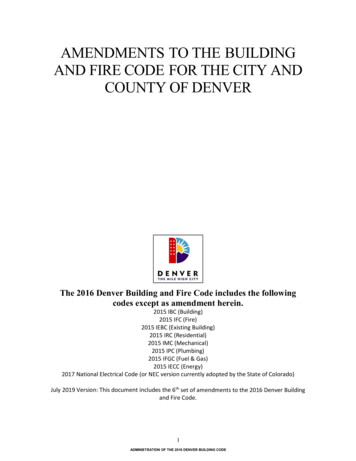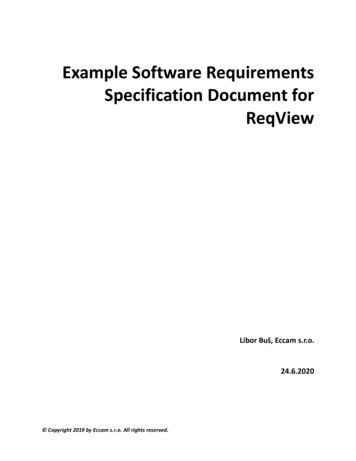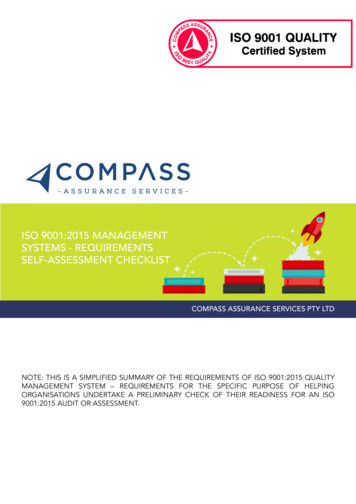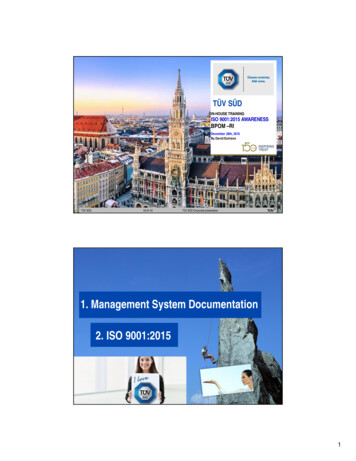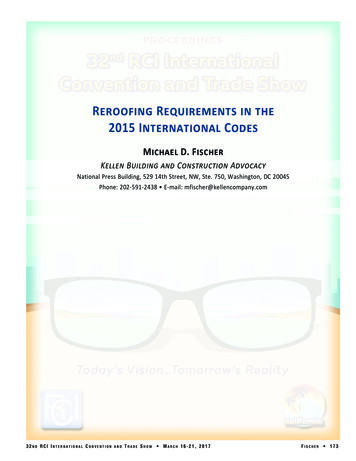
Transcription
Reroofing Requirements in the2015 International CodesMichael D. FischerKellen Building and Construction Advocacynational Press building, 529 14th street, nW, ste. 750, Washington, DC 20045Phone: 202-591-2438 E-mail: mfischer@kellencompany.com32nd RCI InteRnatIonal ConventIonandtRade Show MaRCh 16-21, 2017FISCheR 173
AbstractReroofing is one of the most common construction projects. In order to fully understandthe code requirements for reroofing projects, it is necessary to review three separate codes.The IBC contains the basic material requirements for roof covering assemblies. Other provisions for reroofing can be found in the International Existing Building Code (IEBC) and theInternational Energy Conservation Code (IECC). Recent clarifications to the codes for reroofing have improved their clarity, but given the need to coordinate the provisions across threecodes, many will benefit from a reroofing review.SpeakerMichael D. Fischer – Kellen Company, Washington, DCMichael Fischer, an industry professional for 33 years, has held management positionsin regulatory affairs, manufacturing, and marketing. A member of the International CodeCouncil (ICC), the American Society of Heating, Refrigerating, and Air-Conditioning Engineers(ASHRAE), and ASTM International, he is the code consultant for the PolyisocyanurateInsulation Manufacturers Association. Fischer has testified before code, regulatory, andlegislative bodies and helped lead successful strategic client efforts from product standardsthrough code and regulatory development. He is a respected contributor to trade publications and a frequent presenter at building industry events and conferences.174 FISCheR32nd RCI InteRnatIonal ConventIonandtRade Show MaRCh 16-21, 2017
Reroofing Requirements in the2015 International CodesBACKGROUNDThe International Code Council (ICC)promulgates a family of model codes thataddress a wide variety of constructionrequirements. With a combination of narrowly focused codes and more comprehensive codes, the International Codes providestate and local jurisdictions with a completeset of construction codes to address thevast majority of construction in the U.S.The ICC was created in the late 1990s withthe merger of three so-called legacy codecouncils. Prior to this merger, the BuildingOfficials and Code Administrators (BOCA),the Southern Building Code CongressInternational (SBCCI), and the InternationalConference of Building Officials (ICBO)each developed and maintained separatebuilding codes. While there was significantcooperation between these three groups,including the maintenance of codes forone- and two-family dwellings and energyefficiency, the basic building codes weremaintained in separate processes.The model code congresses determinedthat it was in the best interests of theconstruction industry to join together andpublish a single family of building codes tostreamline the development process, foster better education and enforcement, andsafeguard public safety. While this mergeralso allowed the consolidation of productapproval entities previously managed assubsidiaries of the various bodies, it wasthe concept of a single set of constructioncodes that gained support of the broaderstakeholders in the construction industry,including governmental entities, buildingdesigners, contractors, and building products manufacturers.The creation of the ICC facilitated thedevelopment of the 2000 InternationalBuilding Code (IBC). The 2000 IBC thusbecame the first truly national buildingcode and paved the way for the developmentof other “I-codes.” Today, the ICC publishesa full family of codes, including the following: International Building Code International Energy ConservationCode32nd RCI InteRnatIonal ConventIonand International Existing Building CodeInternational Fire CodeInternational Fuel Gas CodeInternational Green ConstructionCodeInternational Mechanical CodeICC Performance CodeInternational Plumbing CodeInternational Private SewageDisposal CodeInternational Property MaintenanceCodeInternational Residential CodeInternational Swimming Pool andSpa CodeInternational Wildland UrbanInterface CodeInternational Zoning CodeThe I-Codes are intended to worktogether as “overlay” codes, meaning thatthe requirements across the codes thataddress similar topics, products, and materials ensure that all of these provisionscan be easily interpreted and enforced. Inorder to review the requirements for reroof-ing, we must necessarily determine whichcodes directly affect roofing requirementsfor existing buildings. For the purposesof this paper, and after reviewing the ICCcode collection, we will concern ourselveswith the International Building Code (IBC),the International Energ y ConservationCode (IECC), and the International ExistingBuilding Code (IEBC). The InternationalResidential Code (IRC) also addressesreroofing provisions, but the IRC provisions are coordinated and consistent withthe IBC.REROOFINGHistorically, the I-Codes’ developmenthas tended to focus on new constructionprojects, with comprehensive requirementsfor zoning, site development, permitting,construction, inspections, and everythingin between. For most building productsand systems, new building constructionis the rule. For certain products, however,renovations of existing buildings representa much larger share of the market, andthus, the codes require a specific focus onFigure 1 – Reroofing share.tRade Show MaRCh 16-21, 2017FISCheR 175
the requirements for building renovations.For example, window replacement projects are governed by specific code requirements scattered throughout the codes. Roofreplacement is another example of the needfor detailed and specific construction codes.According to a study by the Center forEnvironmental Innovation in Roofing (Hoff,2009), about 4 billion sq. ft. of roof coverings are installed each year in the U.S. Ofthat market, about 3 billion square feet areapplied on existing buildings. (See Figure1.) For roofing projects, it becomes clearthat reroofing is the rule, and new building installation is the exception. While theshare of the roofing market that is allocatedto existing buildings fluctuates dependingon overall construction activity, the retrofitmarket as a percentage of total roofing activity within a given market area is relativelystable. It would be helpful, however, to revisitthe data to identify any trends in share.Because roof coverings are intended tolast for decades, the installation of a newroof serves as a rare opportunity to updatethe structure to comply with current codesand standards. The IBC has recognizedthis market need with the inclusion of aseparate section for reroofing. The reroofing requirements in the IBC govern productand material requirements, testing, andinstallation. Before code requirements forreroofing can be interpreted and applied, athorough understanding of the definitionsrelated to roofing and reroofing projects isnecessary.These definitions are included inChapter 2 of the IBC, IEBC, and IECC:ROOF ASSEMBLY. A systemdesigned to provide weather protection and resistance to design loads.The system consists of a roof covering and roof deck or a singlecomponent serving as both the roofcovering, and the roof deck. A roofassembly includes the roof deck,vapor retarder, substrate or thermalbarrier, insulation, vapor retarderand roof covering.ROOF COVERING. The coveringapplied to the roof deck for weather resistance, fire classification, orappearance.ROOF DECK. The flat or slopedsurface constructed on top of theexterior walls of a building or othersupports for the purpose of enclos-176 FISCheRing the story below, or sheltering anarea, to protect it from the elements,not including its supporting members or vertical supports.ROOF REPAIR. Reconstruction orrenewal of any part of an existingroof for the purposes of its maintenance.REROOFING. The process of recovering or replacing an existing roofcovering. See “Roof re-cover” and“Roof replacement.”ROOF RE-COVER. The process ofinstalling an additional roof coveringover a prepared existing roof covering without removing the existingroof covering.ROOF REPLACEMENT. The processof removing the existing roof covering, repairing any damaged substrate, and installing a new roofcovering.Note that the term “reroofing” includestwo vastly different renovation processes:roof re-cover and roof replacement. Roofre-cover governs those projects where a newroof covering is applied without modification to the existing covering, except perhapsthe preparation of the existing roof coveringin order to facilitate a proper new coveringinstallation.Roof replacement governs the removalof the existing roof covering. By this definition, any damaged substrate that is part ofthe roof assembly or the supporting structure must be repaired prior to proceedingwith the new roof installation. As mentioned above, it is necessary to consider allrequirements to fully capture the intent ofthe code. In this case, the reroofing provisions in Section 1511.3 of the IBC provideadditional instruction:1511.3 Roof Replacement. Roofreplacement shall include theremoval of all existing layers of roofcoverings down to the roof deck.The IBC definition of roof replacementincludes the caveat that any damaged substrate be repaired; Section 1511.3 makes itclear that the code intends that roof replacement include exposing the roof deck by theremoval of the existing materials and roofcovering layers. An exception to this requirement was added to the IBC to address theissue of removing ice barrier membranes;32nd RCI InteRnatIonal ConventIonthese materials form a bond with wooddecks, and their removal could result inunnecessary damage to the roof deck:Exception to IBC 1511.3: Wherethe existing roof assembly includesan ice barrier membrane that isadhered to the roof deck, the existing ice barrier membrane shall bepermitted to remain in place andcovered with an additional layer ofice barrier membrane in accordancewith Section 1507.ROOF RE-COvERINGRoof re-covering is governed by severalsets of requirements in the IBC. Typically,the number of roof covering layers is limited to two, but there are exceptions. Forexample, the application of additional layers of protective coatings over spray polyurethane roof systems is not limited to twolayers. Because these coatings have little ifany impact on roof dead loads, it makes nosense to require the removal of an entireroof system when additional coatings canprovide the necessary weatherproofing.Exception 3 to IBC Section1511.3: The application of a newprotective coating over an existingspray polyurethane foam roofingsystem shall be permitted withouttear off of existing roof coverings.It is anticipated that this exceptionwill be expanded to include coatings onadditional substrates in future versions ofthe code. Other exceptions address specificissues with certain roof covering systems,including structural provisions for standing-seam systems and application of newsystems over existing wood shake roofs.Another provision added to the IBCin 2015 provides an additional optionwhere a product manufacturer develops anapproved system. Under IBC definitions, theterm “approved” indicates that the code official has the final say on acceptance of thesystem. This provision is intended to fosterinnovation while maintaining the intent ofthe code.Exception 1 to IBC Section1511.3: Where the new roof covering is installed in accordance withthe roof covering manufacturer’sapproved instructions.andtRade Show MaRCh 16-21, 2017
Figure 2 – Minimum thermal insulation R-Value requirements.There are other provisions affecting roofrecovering in the IECC. In the 2012 IECC,roof re-covering projects were exempt fromenergy-efficiency measures via an exceptionfound in C101.4.3Exception 5 to C101.4.3: Reroofingfor roofs where neither the sheathingnor the insulation is exposed. Roofswithout insulation in the cavity andwhere the sheathing or insulationis exposed during reroofing shall beinsulated either above or below thesheathing.Note the use of the term “reroofing” inthe above text. The 2012 IECC did not contain definitions for reroofing, roof re-cover,or roof replacement, but a strict reading ofthe above exception with consideration ofthe IBC definitions provides a full understanding of the exception. The 2015 IECCincludes the necessary definitions and aspecific exception from the energy coderequirements for roof recover, provided theenergy use of the building is not increased.That caveat would typically apply only insouthern climate zones where reflective roofrequirements and existing building conditions trigger a review of the new roof covering reflectance.It is also important to note that theseenergy code provisions apply when the roofassembly is part of the building thermalenvelope. Another change in the 2015 IECCexempts roof re-cover and roof replacementprojects from air barrier requirements.Given the use of blower door testing to validate air leakage performance of buildings,a reroofing project in and of itself will likelyimprove the building tightness, but should32nd RCI InteRnatIonal ConventIonandnot trigger a review and possible upgrade ofthe entire building envelope.ROOF REPLACEMENTThe 2012 IECC Exception 5 (see above)also includes a provision that roof replacement projects (that are part of the buildingthermal envelope) are not exempt from theroof insulation requirements of the IECC.That exception is muddy; it uses “sheathing”instead of “roof deck” and refers to a “cavity”without specifically indicating whether it isa cavity within the roof assembly or an atticor plenum cavity. Despite the confusion, theexception does include a requirement buriedin the exception that when the sheathing (ordeck) is exposed, the roof shall be insulated.While it is not proper code formatting to havean exception to an exception, the intent isclear: For the replacement of roofs that arepart of the thermal envelope, and wherethe insulation is above the deck, the coderequirements apply.The IEBC also includes guidance onrenovation projects. For example, Section708.1 of the IEBC includes the followingtext:Level 1 alterations to existing buildings or structures are permittedwithout requiring the entire building or structure to comply withthe energy requirements of theInternational Energy ConservationCode or International ResidentialCode. The alterations shall conformto the energy requirements of theInternational Energy ConservationCode or International ResidentialCode as they relate to new construction only.tRade Show MaRCh 16-21, 2017Roof replacement projects meet the definition of Level 1 alterations in the IEBC.In fact, Section 706, addressing “reroofing”was added to the 2015 IEBC, along with thenecessary definitions governing roofing aslisted above.In order to clarify the roof replacementrequirements, the 2015 IECC was updatedto include specific guidance for roof replacement projects where the roof assembly contained “insulation entirely above deck.” Anew section was added to the code:C503.3.1 Roof replacement. Roofreplacements shall comply withTable C402.1.3 or C402.1.4 wherethe existing roof assembly is part ofthe building thermal envelope andcontains insulation entirely abovethe roof deck.While this clarification does not addressall roof replacement configurations, it doesaddress a significant portion of the roofing market. This provision requires thatroof replacement projects consider energy-efficiency requirements when the roofassembly has insulation above the deckand is part of the thermal envelope. Theprovisions provide two options for compliance: R-Value (Table C402.1.3) or assemblyU-Factor (Table C402.1.4). Those two tablesare consolidated in Figure 2.ASHRAE REQUIREMENTSNote that Figure 2 refers to ASHRAEStandard 90.1-2013. ASHRAE 90.1 is analternative to the IECC provisions. TheIECC addresses specific compliance alternatives:FISCheR 177
C401.1 Scope. The provisions inthis chapter are applicable to commercial buildings and their buildingsites.C401.2 Application. Commercialbuildings shall comply with one ofthe following:1. The requirements of ANSI/ASHRAE/IESNA 90.1.2. The requirements of SectionsC402 through C405. In addition, commercial buildingsshall comply with SectionC406 and tenant spacesshall comply with SectionC406.1.1.3. The requirements of SectionsC402.5, C403.2, C404,C405.2, C405.3, C405.4,C405.6 and C407. The building energy cost shall be equalto or less than 85 percentof the standard referencedesign building.In the 2015 IECC, the R-Value andU-Factor requirements for thermal envelopeprovisions contain the same values. For roofreplacement projects, which are the ruleand not the exception, this consistency isimportant. Differences in various envelopeprovisions for a new building may not be anissue when the overall building efficiency iscomparable between the IECC and ASHRAE90.1, but roof replacement projects oftenconsist of only one envelope alteration.MATERIAL AND INSTALLATIONISSUESThe IBC default requirement for reroofing assumes that the provisions of the codefor material and installation of roof assemblies in new buildings prevail for reroofingprojects. In IBC Section 1511.1, the codecalls out the entire roofing chapter:1511.1 General. Materials andmethods of application used forrecovering or replacing an existingroof covering shall comply with therequirements of Chapter 15.There are exceptions to these requirements, however. The IBC does recognizesome limitations for existing buildings, andspecifically exempts roof slope and secondary roof drain requirements, provided thenew installation establishes positive roof178 FISCheRdrainage. It is important to note that notwithstanding these exemptions, the structural provisions for ponding detailed inChapter 16 of the IBC remain in place.With the above reference to Chapter15, all of the roof assembly requirementsdetailed in Chapter 15 apply to the installation of new materials during reroofing projects. Those requirements include weatherprotection, roof performance requirements(such as wind resistance), fire classification, material, and roof covering (and othercomponents, including underlayment materials) requirements, roof insulation, radiantbarriers, and rooftop structures and equipment, including solar photovoltaic panelsand modules.The IBC includes specific detailed provisions for the application of roofing materials, but also relies heavily on materialand application standards developed byother consensus bodies, including ASTMInternational. In many cases, roof-coveringprovisions governed by these referencedstandards are detailed in lists or tables.For example, IBC Table 1508.2 lists specific types of roof insulation with the corresponding applicable referenced standard.(See Figure 3.)STRUCTURAL CONCERNSThe IEBC also contains a specific provision for roof replacements in high-windareas:707.3.2 Roof diaphragms resistingwind loads in high-wind regions.Where roofing materials are removedfrom more than 50 percent of theroof diaphragm or section of abuilding located where the ultimatedesign wind speed, Vult, determinedin accordance with Figure 1609.3(1)of the International Building Code,is greater than 115 mph (51 m/s) orin a special wind region, as definedin Section 1609 of the InternationalBuilding Code, roof diaphragms,connections of the roof diaphragmto roof framing members, and roofto-wall connections shall be evaluated for the wind loads specifiedin the International Building Code,including wind uplift. If the diaphragms and connections in theircurrent condition are not capable ofresisting at least 75 percent of thosewind loads, they shall be replaced orstrengthened in accordance with theloads specified in the InternationalBuilding Code.This provision garnered considerableattention during the 2016 IBC hearings;the update to ASCE-7 2016 includes significant wind uplift pressure requirementsfor many roof assembly systems governedby the component and cladding loads. The75% threshold included above will likelybe triggered under the 2018 IEBC withthe inclusion of the increased loads underthe ASCE-7 update. In high wind areas,this IEBC provision will require a structural evaluation be performed for all roofreplacement projects, and may necessitateenhanced structural connections, including roof-to-wall. If connection upgrades arerequired on a specific project, the projectwill likely require additional crews to perform the necessary modifications to the[BF] Table 1508.2Material Standards for Roof InsulationCellular glass boardasTM C552Composite boardsASTM C1289, Type III, IV, V, or VIexpanded polystyreneasTM C578extruded polystyreneasTM C578Fiber-reinforced gypsum boardASTM C1278Glass-faced gypsum boardASTM C1177Mineral fiber insulation boardASTM C726Perlite boardasTM C728Polyisocyanurate boardasTM C1289, Type I or IIWood fiberboardASTM C208Figure 3 – 2015 IBC Table 1508.2.32nd RCI InteRnatIonal ConventIonandtRade Show MaRCh 16-21, 2017
building structure. Projects that wouldhave been simple roof replacement mayneed to include other trades; the potentialfor the disruption of building operationsdue to the need for crews to work within thebuilding, as opposed to just rooftop activity,should not be dismissed.FUTURE CODE PROvISIONSDuring the development of the 2018IECC, a proposal (CE287-16) was submitted by the National Roofing ContractorsAssociation (NRCA). CE 287 contained aproposed exception (underlined below) tothe requirement in C503.3.1:C503.3.1 Roof replacement. Roofreplacements shall comply withTable C402.1.3 or C402.1.4 wherethe existing roof assembly is part ofthe building thermal envelope andcontains insulation entirely abovethe roof deck.Exception: Where therequired R-value cannotbe provided because of thethickness limitations presented by existing rooftopconditions, including heating, ventilating and airconditioning equipment, lowdoor or glazing heights, parapet heights and roof flashingheights, the maximum thickness of insulation compatible with the available spaceand existing uses shall beinstalled.The IECC committee voted to recommend disapproval of CE287-16 during theIECC committee hearings in April 2016.During debate, the committee expressedconcern with the broad nature of the exception and the commensurate impact onenergy efficiency, primarily because theproposed exception could apply to an entirebuilding when the condition that triggeredthe exception is limited to only one portionof the roof. One of the committee memberssuggested that a review by the code officialwould be one way to ensure that the intentof the code would be met when applying theproposed exception. Other concerns wereraised during testimony about basing theproposed exception on insulation thicknessinstead of R-Value, which could conflictwith the intent of the code.32nd RCI InteRnatIonal ConventIonandThe committee reason statement forrecommending disapproval read as follows:Committee Reason: This text needsto defer to the AHJ for determination or should specify a minimumR-value. The exception could beused as justification to do nothing toimprove the roof insulation.In response to some of the committeeconcerns, NRCA submitted a public comment to CE287-16 for consideration in theIECC Public Comment Hearing in October2016. RCI submitted the same public comment, which included a modified version ofthe exception with required approval by thecode official.C503.3.1 Roof replacement. Roofreplacements shall comply withTable C402.1.3 or C402.1.4 wherethe existing roof assembly is part ofthe building thermal envelope andcontains insulation entirely abovethe roof deck.Exception: W here therequired R-value cannotbe provided because of thethickness limitations presented by existing rooftopconditions, including heating, ventilating and airconditioning equipment, lowdoor or glazing heights, parapet heights and roof flashingheights, the maximum thickness of insulation compatible with the available spaceand existing uses shall beinstalled where approved bythe code official.Testimony during debate on the provision included a consensus that the proposed modification did, in fact, improve theoriginal proposal, but there was disagreement regarding the technical provisions.It was also noted that the public commentsolved one of the issues raised by the IECCcommittee but failed to address scoping,thickness, and R-Value concerns, and theoverall impact of such a broad exception onenergy efficiency.IECC requires that public commentlanguage receive two-thirds of the assembly vote during the public comment hearing in order to be considered during thetRade Show MaRCh 16-21, 2017ICC Online Governmental Consensus Vote(OGCV), and then be ratified by a twothirds majority of the OGCV. CE298-16did receive the required two-thirds duringthe public comment hearing, but did notreceive the two-thirds required vote in theOGCV. The 2018 IECC will thus contain thesame provisions for roof replacement as the2015 IECC. It seems likely that there willbe additional discussions surrounding thisrequirement in future ICC code development proceedings.STATE CODE ADOPTIONSThe ICC publishes the model I-Codes,but these codes are often modified at thestate level. Some states have modified therequirements for roof replacement, whileothers have exempted some classes of buildings from the provisions. As the 2018I-Codes are adopted during state and localupdates, it should be expected that theissue of the structural and energy-efficiencyrequirements will be revisited.Proposals to provide a remedy for thestructural triggers of the IEBC are beingdeveloped for consideration by the FloridaBuilding Commission in February of 2017.If successful, it is expected that they willbe proposed with other state code adoptions in high-wind regions. The Floridaproposal will likely focus on additionalexceptions to the IEBC structural trigger,focusing the requirement on older buildingsconstructed prior to the first edition of theFlorida Building Code. While this option isavailable only in Florida, due to the state’shistory of code development, it may providea template for other states.CODE DEvELOPMENTPARTICIPATIONThe ICC develops and maintains codesin a hybrid consensus model. While thepublic comment and final action votingare limited only to the ICC governmentalmembers who represent their local or statejurisdiction, the remainder of the processis open to all interested parties. Anyonecan submit code proposals and public comments, and testify during the code hearings. Industry and public interest ICC members are included on the code developmentcommittees. In this manner, ICC is able totap into available knowledge and researchfrom both the public and private sectors.Participating stakeholders in the ICCprocess include product manufacturers,FISCheR 179
trade associations and professional societies, construction consultants, buildingdesigners, contractors, and, in fact, anyparty interested in construction codes andstandards. RCI is an active participantwithin the ICC process; RCI members andall industry consultants are encouragedto engage with ICC code development byjoining the ICC, learning the process, andbringing their experience and knowledge tothe table.180 FISCheRCONCLUSIONThe I-Codes provide a comprehensiveset of requirements governing reroofingprojects. When evaluating the roofing market, which consists of a three-to-one ratio ofreroofing to new building, the importance ofapplying code requirements for roof assemblies on existing buildings cannot be overstated. The opportunity to upgrade roofingto meet current provisions for weatherization, fire safety, structural provisions, and32nd RCI InteRnatIonal ConventIonenergy efficiency should not be missed, orit will likely be decades in the future beforethese kinds of building enhancements canbe made. Despite the progress made at themodel code level, additional work on otheraspects of reroofing requirements to cleanup the code provisions is necessary. In fact,industry stakeholders and participants inthe ICC and ASHRAE code process arealready collaborating on the next cycle ofcode development.andtRade Show MaRCh 16-21, 2017
2015 International Codes. Michael D. Fischer. Kellen Building and Construction Advocacy . national Press building, 529 14th street, nW, ste. 750, Washington, DC 20045 . sions for rerooing can be found in the International Existing Building Code (IEBC) and the International Energy Conservation Code (IECC). Recent clariications to the codes for .


